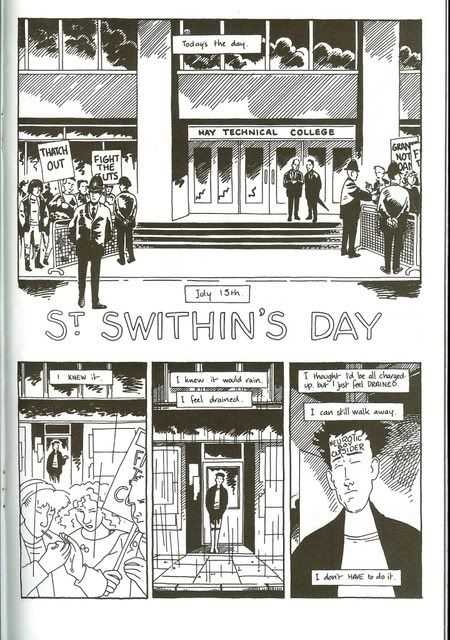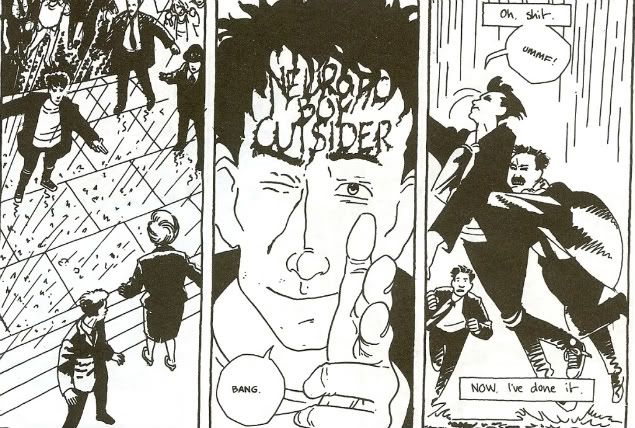This is the conclusion to my review of St Swithin's Day, Grant Morrison's indie one-shot comic. It's from a while back, but I've moved it to a forum thread as the Morrison group where I originally posted it is about to go kablooey. I don't advise reading this unless you have read the first part, and then only if you don't mind having the excellent ending of this clever little comic spoiled for you.
You've been warned.
Fourth Chapter – St Swithin’s Day.
This is the spoilerific conclusion to my review of Morrison and Grist's St Swithin's Day. All of my previous reviews of Morrison's work have been written with readers familiar with the work in mind. I knew that St Swithin's Day has been hard to get a hold of, but I was itching to discuss it all the same, so I wrote this series of posts partly to familiarise Morrison fans with the actual content of the comic, as well as discuss it. With that caveat - onwards.
I left my Oni Press copy of St Swithin’s Day (which is in black and white) at work, so I’m reviewing the final 6 pages from my Trident Comics edition from 1989. Apart from the different cover, it is in colour and the chapters are titles First Chapter through to Fourth Chapter. This is badly thought through, as within the story each chapter is titled in countdown from Day Four to St Swithin’s Day itself. The colouring, by Steve Whittaker is in vey muted pastel tones and is very sympathetic to Grist’s art. The colour might be another step towards the US superhero comics that Morrison was working towards breaking into when this story was originally being put together
The final day is note perfect and a brilliant wrap up of the story. Grant builds the tension by keeping the focus on the protagonist's thoughts and his stomach-churning nerves leading up to his act of defiance. Ironically, it all comes across as very real to us precisely because the narrator gets across how unreal it seems to him. Reality has a different sheen when we are pushed way outside our comfort zone by fear and anxiety in a threatening situation.

We also get a little more insight into what our anti-hero is bucking against.
“I know what they’ll say about ME – they’ll put me into a slot. Ad-Men with their consumer categories. They think they are so brilliant. They have categories for EVERYONE; Housewives and teenagers , trainspotters and Greenpeace supporters. Everyone except AD-MEN.”
Of course, the 80s were a boom time for 'Ad-men', as fans of Thirty-Something will remember. (There’s a show we never hear about anymore! Must be embarassment!) Consumerism and societal control are some of the things that are bugging our lad. He mocks their possible categorisation of him, by writing ‘Neurotic Boy Outsider' on his forehead in biro before he steps out to meet Thatcher. (Shades of Travis Bickle here.)
Well, I’ll let Grist take it from here:

No gun!!

As Thatcher’s plain-clothed minders tackle the apparent assassin/nutso to the ground, giving him a good roughing up in the process, he thinks –
“Worth it. It was WORTH it. It was worth it just to see her SCARED...”
The last few panels cut through a bright panel of perfect whiteness to our hero travelling on a train, feeling the breeze coming through the window and the sunshine on his face. As we close on a his smiling sunlit face (looking, it must be said, the most like a young Grant Morrison of any of the panels in the book) he thinks:
“And I don’t care if it rains. I really don’t care at all”
I just love the ending of this story. It starts out so grim and Eighties. Unemployment, Thatcherism and despair, and takes us on a journey through catharsis to this point.
There’s so much to say about the ending. Although the story is as close to gritty realism as Grant has ever done, the non-existent gun at the end is a vindication of imagination and fantasy. It’s also a statement that the pettiness and divisive hatred that Thatcher thrived on needn’t bring forth pettiness and hatred in those opposed to her values. In leaving behind the gun, he’s able to show that there is an alternative to the Iron Lady’s warmongering, arms-dealing ways. That he is able to make her feel some of the fear that she brought to the lives of those outside her tent at the same time is a bonus!
Actually, the imaginary gun lifts it above the whole context and away from Thatcher completely. Even as he’s getting his beating, our hero thinks that it’s worth it. He has overcome his fears and all the constrictions that society and his own psyche have placed on him. He has found the strength to actually do something in the world, rather than be a ‘neurotic boy outsider’ looking in. Various forces, external and internal had made him a spectator rather than a participant. Internalising the passive values of a consumerist society will do that to you.
He was in a bind and it took a major act of catharsis to redefine himself.
In effect, it’s art that saves him. Publically shooting Thatcher with an imaginary gun is like a radical form of conceptual art. Thatcher drove a materialist revolution that saw no value in art beyond the inflated prices that her gifted political spin-doctors Saatchi and Saatchi were able to acquire for their galleries full of art. The imaginary gun in the hand of a disaffected teenager is not something that any amount of Ad-men’s millions could buy!
Once the deed is done, the boy is free. For all the degradation and fear of Thatcher’s consumerist Britain, he has realised that it’s what he does and what he makes of the world that matters. The ad-men and politicians are beneath him now.
Perhaps these are platitudes, but as often in Morrison’s work, our hero has been changed by living through an experience rather than simply learning something passively.
This is just a cracking little comic, with a lot to say. Look out for it in a bargain bin near you soon!
************
The climax of St Swithin’s Day turns on the primacy of fantasy and imagination over dreary realism, but there’s a lot in this little comic that connects overtly to Morrison’s later fantasies, and I've looked at them in the August 9 2010 comment in the original thread.
Replies
I can't imagine better art for the job here.
I picked up both the copies I had for 50c each.
Art and commerce can be so far apart sometimes....